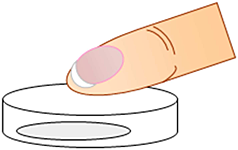Urine or blood are generally used to prove drug intake in forensic investigations. However, suspects must be escorted into a lavatory or a medical office and observed by a police officer to prevent falsification. Special techniques and facilities are required. Alternatively, saliva and fingerprints (secretions from fingertips) could be sampled non-invasively, quickly, and easily on site by police officers.
Kenji Kuwayama, National Research Institute of Police Science, Chiba, Japan, and colleagues have monitored in three volunteers 14 analytes (the administered drugs and their main metabolites) in urine, blood, saliva, and fingerprints for approximately four weeks after four pharmaceutical products were administered.
Most of the 14 analytes were detected in saliva, fingerprints, urine, and blood. The time-courses of drug concentrations were similar between urine and fingerprints, and between blood and saliva. Compared to the other compounds, the acidic compounds – such as ibuprofen and acetylsalicylic acid –, were more difficult to detect in all specimens. Acetaminophen, dihydrocodeine, and methylephedrine were detected in fingerprints at later sampling times than in urine. A relationship between the drug structures and their detection periods in each specimen was not found.
According to the researchers, saliva and fingerprints could initially be taken on site to prevent the loss of evidence, when it is difficult to obtain urine and blood immediately or when it is suspected that rapidly metabolized drugs were used. They recommend that the detection of drugs in saliva and fingerprints support the analytical results in urine and blood samples and help determine which drugs were consumed.
- Effectiveness of saliva and fingerprints as alternative specimens to urine and blood in forensic drug testing,
Kenji Kuwayama, Hajime Miyaguchi, Tadashi Yamamuro, Kenji Tsujikawa, Tatsuyuki Kanamori, Yuko T. Iwata, Hiroyuki Inoue,
Drug Test. Analysis 2015.
DOI: 10.1002/dta.1831




